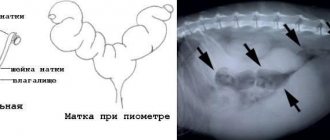How normal is it for a cat to ask for a male cat after sterilization?
In principle, there is nothing “supernatural” about this. The reason is the same why unsterilized pets are “thirsty” for cats: hormones. In vain, many owners who have nothing to do with veterinary medicine believe that after sterilization, these substances disappear from the animal’s body instantly.
This is impossible for purely physiological reasons:
- Partial hormones always remain in the pet’s blood and plasma, and the “blood” reserves can last for a long time. For some cats, the process of hatching lasts for several months.
- In addition, hormones accumulate intensively in subcutaneous tissue and other fat reserves in the cat’s body. The more well-fed the pet was at the time of sterilization, the longer it will show “echoes” of typical sexual behavior. There are cases when a cat, which was operated on a year ago, begins to scream from time to time, clearly demanding the presence of the cat. This doesn’t happen too often, but this phenomenon is also not unique.
Should a cat stop marking?
The female stops marking after sterilization if she has not yet reached sexual maturity at the time of the operation. Otherwise, such sexual behavior has already been established, and the lack of hormones may not affect it.
In addition, this behavior completely depends on the character of the cat. She may not like such a small thing as the location of the tray, unknown and unpleasant odors, or simply the surrounding environment, but she can express her dissatisfaction in one of the few ways - by leaving marks.
The owner can deal with this problem in several ways.
- Ensure good ventilation in the house, eliminating unpleasant odors.
- Make sure the cat is not bothered by anything. In case of anxiety, you can rub flower infusions into the inside of the ear. They can also be added to the water that the animal drinks - no more than 1-2 drops.
- Special preparations sold in pet stores can eliminate the odors of existing marks. Their use is quite lengthy: most often, the areas marked by the cat must be treated every day for a month.
Reference!
Of course, all of the above should be put into effect only after the owner is convinced that sexual behavior has been consolidated and the operation has been performed correctly. If the production of hormones in the cat's body continues, the above methods may not help.
The cat keeps asking for the cat: behavioral features
When, after sterilization, the pet continues to ask for a cat, the following behavioral characteristics are observed:
- From time to time the animal seems to “wakes up” and begins to meow hoarsely, “invitingly”.
- Periods of sexual arousal in sterilized cats do not last long, ending suddenly just as they began.
- Another thing is much more unpleasant. The problem is that a sterilized cat often marks its territory, despite its “inferiority.” Alas, this habit remains with the pet for a long time, sometimes for the rest of its life.
There is only one consolation - over time, the intensity of the smell of discharge in operated animals weakens greatly.
Of course, you shouldn’t hope for its complete disappearance, but still, the stable amber gradually disappears (in about six months, sometimes it takes longer).
What is the essence of cat marks?
After sterilization, your cat can continue to do the following:
- approach a wall or furniture;
- raise your tail high and shake it;
- release a small amount of urine.
Marks in an apartment from a sterilized cat can mean protection of one’s territory, preserved sexual instinct, or discomfort when staying indoors.
If a cat lives in the neighborhood, the female senses this and marks the corners to attract an individual of the opposite sex. The rest of the time, she can simply defend the territory from foreign animals, which she senses by smell. If you are bringing a new pet into your home, be prepared to purchase a separate litter box and designate a different area for feeding. At first, you may even have to place the cats in different rooms to make the animals feel safe.
Representatives of cats may begin to mark their territory due to the appearance of strangers in the house. If you leave a sterilized cat on vacation with a person whom the pet has not seen before, she may experience stress and for this reason leave marks. If the animal is under severe stress, the veterinarian may also prescribe sedatives. Funds are also prescribed when moving to another home, renovating or purchasing new furniture. It happens that over time the pet’s behavior returns to normal without outside help.
Sometimes animals tend to leave marks when they have urolithiasis. To rule out health problems in your cat, you need to bring the animal to the veterinary clinic for examination once a year.
Reasons for unwanted pet behavior in the home
Mainly cats prefer to leave urine marks on home furniture, walls and corner parts of the room.
Using this method, they attract attention to themselves. Yellow cat urine has a characteristic, persistent odor that attracts the attention of cats, and at the same time, repels other cats. Before spraying surrounding objects with urine, the cat straightens its hind legs and lifts its tail. With such a gesture, the pet seems to give a signal to other animals that he has taken this place, and strangers are prohibited from entering here.
There is a statement that only cats can leave their marks. In fact, many owners have had to deal with the problem of a cat marking in the house. It should be noted that such improper behavior of a furry pet in the house is often associated with the need to increase self-confidence. This happens at moments when your pet feels unprotected and very excited.
© shutterstock
Contrary to the well-established statement that after castration (sterilization), cats stop irrigating rooms in an apartment or house with their urine, some individuals continue to do this. There are several reasons why a sterilized animal continues to mark its territory.
- During the operation, the veterinarian did not completely remove the ovarian tissue. The cat's owner needs to visit the veterinary clinic once with the animal to have an ultrasound done. If some of the ovarian cysts remain, they will be visible on the image, and the specialist will prescribe an additional operation to remove them.
- The cat was sterilized when the animal reached sexual maturity. Many owners of purring pets have noticed that after sterilization the cat still marks. Veterinarians explain this behavior by the fact that the animal has retained parental and sexual behavior. It has already established itself at a high level, so hormonal influence and sterilization do not give a lasting effect.
- One of the reasons why a sterilized cat marks is its unmet mental needs. The animal may not like the environment, the location of the tray, or the change in the room after renovation, and therefore marks appear on surrounding objects.
The main reasons for leaving marks by a cat after castration
If you notice that your neutered cat continues to mark his territory, you need to calm down and contact your veterinarian. The doctor will examine the animal and tell you why its behavior has not changed after the operation. There may be several reasons why a neutered cat leaves marks.
Postoperative period
Within several months after castration, the animal recovers, its hormonal system is rebuilt to a new level of functioning. The amount of sex hormones decreases gradually, which explains the appearance of marks within 3–4 weeks after surgery. Owners must be patient and wait for their pet’s reproductive instinct to completely fade away.
Late castration
The habit of marking its territory may continue after surgery if it was performed at puberty, especially if the cat has already had sexual contact with cats. In this case, the animal can leave marks on walls, shoes, things and furniture for 6-12 months. Fortunately, after castration, the typical “male” pungent smell of urine becomes significantly less. Usually, after a hormonal adjustment, this habit disappears, the animal calms down and forgets about the old behavior.
Cryptorchidism, poor castration
If one testicle remains in the scrotum, traditional surgery is contraindicated. Otherwise, the production of sex hormones will not be stopped. To solve the problem of marks, and other, more serious problems, such an animal undergoes abdominal surgery. A testicle in the abdominal cavity can degenerate and cause cancer.
Chronic diseases of the genitourinary system
Sometimes the reason why a castrated cat continues to urinate outside the tray is the appearance of urolithiasis, cystitis and other pathologies that are accompanied by difficulty in the outflow of urine and involuntary urination. In this case, we are not talking about marks, but about pain when urinating.
Severe stress
If the cat is nervous, he may mark in the house. Various factors can provoke such changes, including the transition to a new diet and the owner ignoring the pet, the appearance of another cat nearby or a new pet in the apartment.
What to do if the cat continues to walk after sterilization?
The owner has the following options for dealing with the pet’s wandering behavior despite the surgery:
- You need to be patient and wait until the concentration of hormones that were produced before sterilization drops.
- Carry out a repeat operation. In most cases, it is financed by the surgeon who performed the first one. However, it should be noted that all anesthesia drugs have side effects.
- If estrus occurs, use medications to regulate sexual heat, which will be prescribed by a veterinarian.
Preparations for regulating sexual heat in cats
If a sterilized cat develops heat and produces characteristic meowing, rolling on the floor, and spreading puddles across the floor, phytosterol-based calming medications are used.
In their structure, the substances contained in biological additives resemble sex hormones. The cat develops the feeling that mating has occurred and she calms down.
The advantages of the drugs are their harmlessness and mild action. The disadvantage is that they must be given several times a day for several days. The following herbal sedatives are in demand:
- FITEX is given an hour before meals or along with food, 3-5 drops per cat with food or treat 3 times a day. During the period of taking the biological supplement, the pet is transferred to three meals a day. The course of taking the drug is 15-30 days. If necessary, treatment is repeated. In addition to correcting sexual behavior, drops are used to relieve stress.
- Kot Bayun tablets are a dried extract of medicinal herbs. Give 3-4 times a day, 20 minutes before and an hour after feeding, 2 pills. The course of treatment is 5-7 days. It is recommended to use it monthly until the problem is eliminated.
- Kot Bayun infusion. It is a herbal tea in bottles. The procedure for taking it is the same. as when using tablets. A single dosage is half a teaspoon.
Be sure to read:
A cat after castration: when he comes to his senses, postoperative care, does behavior change, complications?
An alternative to herbal remedies is a hormonal remedy Sex barrier. An important difference from other drugs is the combination of two hormones. They enhance each other’s effects, which allows them to be used in low concentrations that are safe for health. The drugs are produced in modifications for cats, females, males and females.
A pet should not be given medicine intended for cats, because they contain too high a concentration of active ingredients. If the cat is in heat, give 4 drops per day for 3-5 days. To prevent the onset of estrus, 4 drops are administered to the cat once every 2 weeks.
Some cat lovers prefer to use tablets. The effect of 1 pill is equivalent to 4 drops. The application procedure is the same as when using drops.











